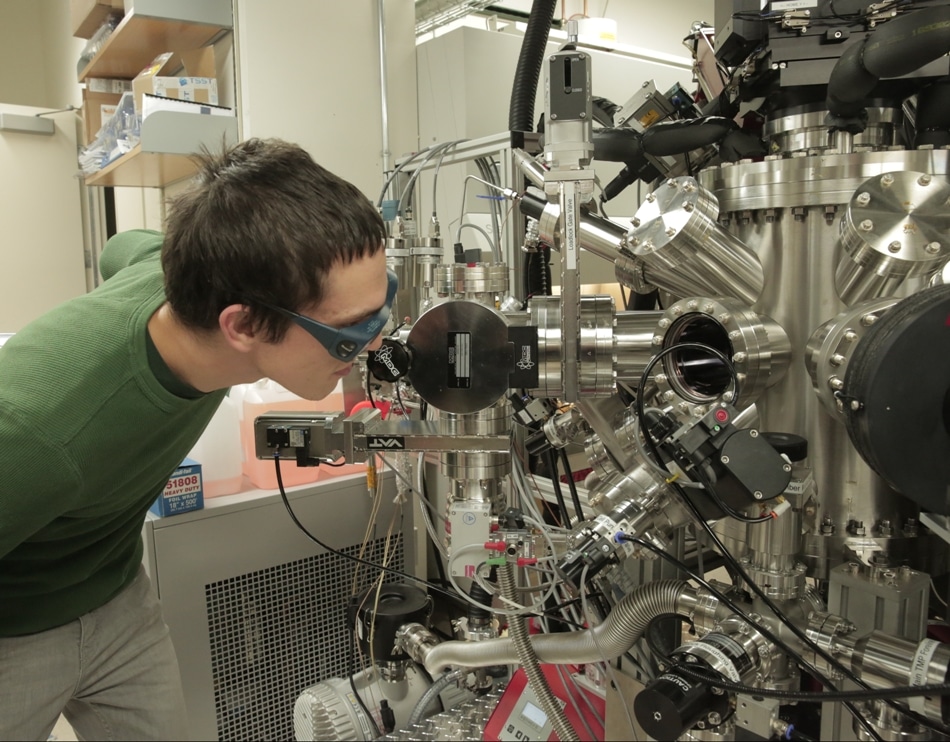Nov 30 2017
Computers and smartphones wouldn't be as useful as they are without containing a huge number of apps, videos and music.
 Physics graduate student Julian Irwin checks equipment in the lab of materials science and engineering Professor Chang-Beom Eom, where researchers have produced a material that could exhibit the best qualities of both solid-state and spinning disk digital storage. PHOTO: SARAH PAGE
Physics graduate student Julian Irwin checks equipment in the lab of materials science and engineering Professor Chang-Beom Eom, where researchers have produced a material that could exhibit the best qualities of both solid-state and spinning disk digital storage. PHOTO: SARAH PAGE
Devices generally store information in two ways: via electric fields (such as a flash drive) or via magnetic fields (like a spinning hard disk in a computer). Each method has its own advantages and disadvantages. In the future, however, electronics will be able to benefit from the best of each.
There’s an interesting concept, can you cross-couple these two different ways to store information? Could we use an electric field to change the magnetic properties? Then you can have a low-power, multifunctional device. We call this a ‘magnetoelectric’ device.
Chang-Beom Eom, the Theodore H. Geballe Professor and Harvey D. Spangler Distinguished Professor of Materials Science and Engineering at the University of Wisconsin–Madison.
In a recently published research in the journal Nature Communications, Eom and his collaborators explain their unique process for developing a superior-quality magnetoelectric material, and also describe exactly how and why it works.
Magnetoelectric materials, known to have electrical as well as magnetic functionalities, or “orders”, are already in existence. Switching one functionality induces a change in the other.
“It’s called cross-coupling,” says Eom. “Yet, how they cross-couple is not clearly understood.”
According to Eom, this understanding can be obtained by studying how the magnetic properties change upon application of an electric field. Up to now, this has been tough because of the complicated structure of most of the magnetoelectric materials.
Eom says that in the past people studied magnetoelectric properties by employing extremely “complex” materials, or those that do not have uniformity. In his approach, Eom simplified the research and the material itself.
Drawing on his knowledge in material growth, he created a unique process, employing atomic “steps,” in order to guide the growth of a homogenous, single-crystal thin film of bismuth ferrite. Atop that, he added cobalt, which is magnetic; he then placed an electrode made of from strontium ruthenate on the bottom.
The bismuth ferrite material was vital as it enabled Eom to study the fundamental magnetoelectric cross-coupling more easily.
“We found that in our work, because of our single domain, we could actually see what was going on using multiple probing, or imaging, techniques,” he says. “The mechanism is intrinsic. It’s reproducible — and that means you can make a device without any degradation, in a predictable way.”
Eom and his colleagues imaged the changing magnetic and electric properties switching in real time by using the powerful synchrotron light sources at Argonne National Laboratory outside Chicago, and in Switzerland and the United Kingdom.
“When you switch it, the electrical field switches the electric polarization. If it’s ‘downward,’ it switches ‘upward,’” he says. “The coupling to the magnetic layer then changes its properties: a magnetoelectric storage device.”
That change in direction allowed researchers to take the next steps essential for adding programmable integrated circuits to the material. These circuits are the building blocks to the foundation of electronics.
While the homogenous material allowed Eom to answer vital scientific questions about how magnetoelectric cross-coupling takes place, it also could help manufacturers to enhance their electronics.
“Now we can design a much more effective, efficient and low-power device,” he says.
Eom’s team includes both experimentalists and theorists, including UW–Madison physics Professor Mark Rzchowski and collaborators at Diamond Light Source in England, Temple University, the University of Oxford, Argonne National Laboratory, Swiss Light Source, Luxembourg Institute of Science and Technology, and Northern Illinois University.
This research was supported by the Army Research Office (W911NF-10-1-0362 and W911NF-13-1-0486) and the Department Of Energy (DE-FG02-03ER46097 and DE-AC02-06CH11357).